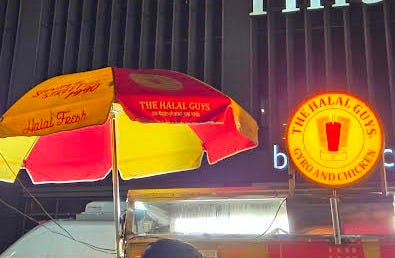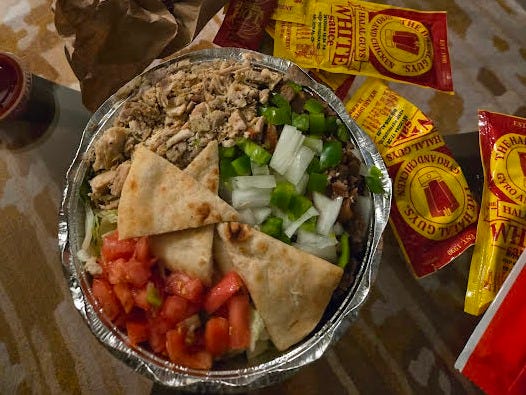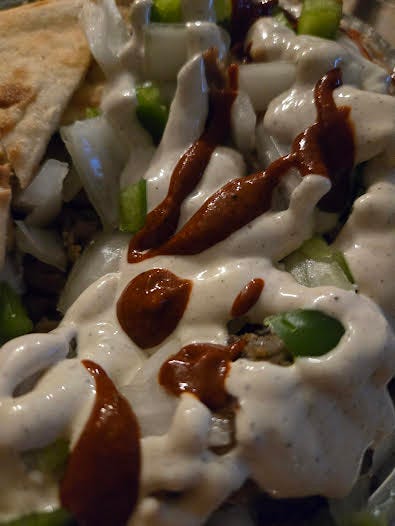I'm gonna let you in on a little secret: NYC food carts mostly suck. It's nice that they exist, I guess, if you're having some kind of hot dog emergency, but you're really scraping the bottom of the barrel. The hot dogs taste burnt despite being boiled in water, and the pretzels always have this ungodly smell reminiscent of overheated brake pads. Most New Yorkers tend to avoid these carts, generally preferring a quick snack from a bodega when in need.
But food carts and street vending have a long history in New York, and the options available weren't always so limited. Push carts originated in the Lower East Side in the late 19th century, and were called "Owls" because they largely catered to night owls. When the sun went down, the carts went out, serving extremely cheap foods like hot sweet potatoes or oysters (when they WERE cheap) when brick-and-mortar restaurants were closed. I've read fond recollections of former Brooklyn kids of the 1910s, who would rush outside when they heard the sweet potato man ringing his bell as the sun began to fade into the horizon.
The golden age of food carts lasted until the 1930s, when mayor Fiorello LaGuardia cracked down on them for supposedly being unsafe and unsanitary, establishing several public markets where vendors sold their goods from stationary stalls. One of these public markets still exists, up in the Bronx on Arthur Avenue, and I suppose Essex Street Market hangs on, albeit in drastically altered form. But these markets marked a steep decline in the variety of street food.
But hot dogs were largely spared thanks to the invention of the modern hot dog, which was compact and featured a built-in steam compartment. Prior to this, food carts were basically shoddy wooden wagons, and often took up entire sidewalks, not to mention their sanitary conditions. So, while the original pushcart culture faded into history, hot dog carts would persevere to become an icon of the city.
In the 1950s, Greek immigrants would come to own many hot dog carts around New York and, perhaps gradually at first, began to offer things like gyro and souvlaki. Often these items would be of higher quality than the hot dogs, which ingratiated these fine entrepreneurs to the city's pedestrians.
Perhaps Greek food offered a bridge to the rest of the Mediterranean, because by the late 1980s, Greek food cart owners were joined by immigrants from Egypt and other parts of the Muslim world. They would come to found what is now known as the halal cart, naturally selling halal-certified meats, catering largely to Muslim taxi drivers. But it wasn't long before the rest of the city began to see the appeal: by 1994, white girl wonder Parker Posey immortalized the halal cart man in the film Party Girl, with her canonical order of "falafel with hot sauce, side order of baba ganouj, and a seltzer."
And that's where Halal Guys comes in. Founded in 1992 by three Egyptian immigrants, they originally started out a few years prior selling hot dogs, but they quickly noticed a gulf between the number of working-class Muslim immigrants in New York, and the amount of halal options able to cater to them. Switching up the format proved incredibly lucrative, and forever changed the face of NYC street food.
They're now a nationwide franchise, of course, but their original location at 53rd St. & 6th Ave is still a destination, drawing long lines at all hours despite the existence of another Halal Guys cart one block west that almost never has a line. Maybe there's just a little more oomph to the original that makes it special. It can be exhilarating to watch the cart workers performing at a feverish pace, chopping and flipping and assembling in teams of 2 or 3 at different stations. Operations here have expanded so much, they need 3 separate carts to keep up with demand: one for grilling the meat, one to hold beverages, and one to assemble falafel sandwiches or bowls of chicken and gyro over rice.
Standing in line, it isn't hard to see why this kind of food took off in the street food format. Anything you can make on a flat top griddle will sell like hotcakes, because it optimizes the limited space a pushcart is working with. Just grill the meat, plop it on some rice, and it's gone.
Now, for some reason, lamb over rice feels like the default halal cart item. But Halal Guys doesn't actually offer lamb. So your choice there is between chicken or gyro beef over rice, or a combination of the two. Much like taco trucks in Los Angeles, halal carts might offer different meats or preparations depending on what region the seller is from. But regardless, the meats at Halal Guys are decently seasoned and usually nice and juicy. At least at the fast-paced original, the meat is always fresh by necessity.
But the real flavor comes from the rice, which carries a vivid orange hue, and the sauces. Red and white sauce are, together, utterly emblematic of the halal cart, perhaps more than the meat itself. The red sauce, an American cousin perhaps of harissa sauce, has a dry, almost smoky heat to it that can get out of hand if not judiciously applied. To balance things out, the white sauce is creamy and garlicky - I have a sneaking suspicion is largely mayonnaise based. Don't use too much of this, or the meal starts getting pretty dense.
Halal Guys also offers falafel. It's decent, but halal cart falafel is not fried to order; it sits around a bit, so while Halal Guys falafel is still reasonably crunchy, it does get a little dense, and the exterior gets slightly leathery. A decent option for the herbivores. There are French fries, too, of the mass-produced crinkle-cut variety you can find at every food cart in Manhattan. They're fine, but it's the halal meat over rice that makes Halal Guys especially remarkable. Best consumed after 10pm for maximum on-line conviviality.







